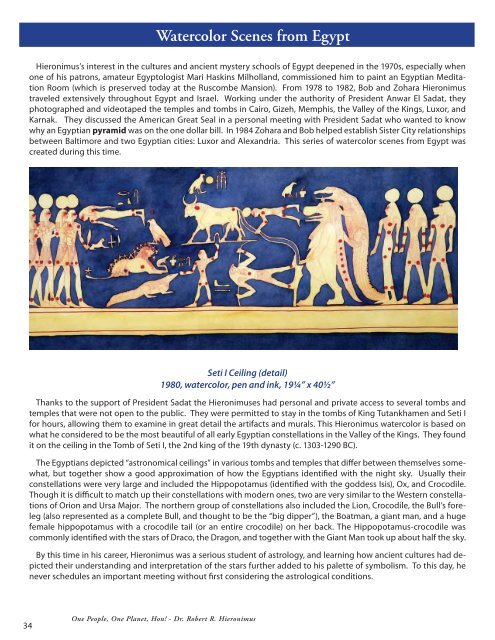One People, One Planet, Hon! Hidden Meanings of Common ...
One People, One Planet, Hon! Hidden Meanings of Common ...
One People, One Planet, Hon! Hidden Meanings of Common ...
You also want an ePaper? Increase the reach of your titles
YUMPU automatically turns print PDFs into web optimized ePapers that Google loves.
34<br />
Watercolor Scenes from Egypt<br />
Hieronimus’s interest in the cultures and ancient mystery schools <strong>of</strong> Egypt deepened in the 1970s, especially when<br />
one <strong>of</strong> his patrons, amateur Egyptologist Mari Haskins Milholland, commissioned him to paint an Egyptian Meditation<br />
Room (which is preserved today at the Ruscombe Mansion). From 1978 to 1982, Bob and Zohara Hieronimus<br />
traveled extensively throughout Egypt and Israel. Working under the authority <strong>of</strong> President Anwar El Sadat, they<br />
photographed and videotaped the temples and tombs in Cairo, Gizeh, Memphis, the Valley <strong>of</strong> the Kings, Luxor, and<br />
Karnak. They discussed the American Great Seal in a personal meeting with President Sadat who wanted to know<br />
why an Egyptian pyramid was on the one dollar bill. In 1984 Zohara and Bob helped establish Sister City relationships<br />
between Baltimore and two Egyptian cities: Luxor and Alexandria. This series <strong>of</strong> watercolor scenes from Egypt was<br />
created during this time.<br />
Seti I Ceiling (detail)<br />
1980, watercolor, pen and ink, 19¼” x 40½”<br />
Thanks to the support <strong>of</strong> President Sadat the Hieronimuses had personal and private access to several tombs and<br />
temples that were not open to the public. They were permitted to stay in the tombs <strong>of</strong> King Tutankhamen and Seti I<br />
for hours, allowing them to examine in great detail the artifacts and murals. This Hieronimus watercolor is based on<br />
what he considered to be the most beautiful <strong>of</strong> all early Egyptian constellations in the Valley <strong>of</strong> the Kings. They found<br />
it on the ceiling in the Tomb <strong>of</strong> Seti I, the 2nd king <strong>of</strong> the 19th dynasty (c. 1303-1290 BC).<br />
The Egyptians depicted “astronomical ceilings” in various tombs and temples that differ between themselves somewhat,<br />
but together show a good approximation <strong>of</strong> how the Egyptians identified with the night sky. Usually their<br />
constellations were very large and included the Hippopotamus (identified with the goddess Isis), Ox, and Crocodile.<br />
Though it is difficult to match up their constellations with modern ones, two are very similar to the Western constellations<br />
<strong>of</strong> Orion and Ursa Major. The northern group <strong>of</strong> constellations also included the Lion, Crocodile, the Bull’s foreleg<br />
(also represented as a complete Bull, and thought to be the “big dipper”), the Boatman, a giant man, and a huge<br />
female hippopotamus with a crocodile tail (or an entire crocodile) on her back. The Hippopotamus-crocodile was<br />
commonly identified with the stars <strong>of</strong> Draco, the Dragon, and together with the Giant Man took up about half the sky.<br />
By this time in his career, Hieronimus was a serious student <strong>of</strong> astrology, and learning how ancient cultures had depicted<br />
their understanding and interpretation <strong>of</strong> the stars further added to his palette <strong>of</strong> symbolism. To this day, he<br />
never schedules an important meeting without first considering the astrological conditions.<br />
<strong>One</strong> <strong>People</strong>, <strong>One</strong> <strong>Planet</strong>, <strong>Hon</strong>! - Dr. Robert R. Hieronimus<br />
The Sphinx and Great Pyramid<br />
1979, watercolor, 18¾” x 22¼”<br />
There is a science to achieving the spiritual dimensions, and the ancient Egyptians were masters <strong>of</strong> these spiritual<br />
sciences. They also left behind instructions on how to safely enter and leave the mystical dimensions. Members <strong>of</strong><br />
contemporary secret societies like Freemasonry and the Rosicrucian Order know that their rituals and mystery plays<br />
are based upon the same principles: learning the stages in the process <strong>of</strong> spiritualization and returning to the source.<br />
Hieronimus was looking forward to figuratively returning to the source and climbing the Great Pyramid and possibly<br />
exploring some past lifetimes when he and his wife and partner, Zohara, planned several trips to Egypt. What he didn’t<br />
expect was to be hit by a sandstorm when he was halfway up his climb to the top <strong>of</strong> the Great Pyramid. The swirling<br />
elements <strong>of</strong> the sandstorm are depicted in this painting <strong>of</strong> the Sphinx and Great Pyramid. He says throughout the<br />
blinding fierceness, as he clung to the rough stone, a tiny dot on the side a huge structure, he reminded himself he<br />
was clinging to the side <strong>of</strong> a temple. He went into an altered state and remembers experiencing the same thing he<br />
had while meditating inside the stone c<strong>of</strong>fer inside the Great Pyramid. Lying in the red granite c<strong>of</strong>fer like thousands<br />
<strong>of</strong> students and candidates for initiation had done before him was one <strong>of</strong> the most memorable experiences <strong>of</strong> his life.<br />
Although the current archeological theory is that the Great Pyramid was nothing more than a tomb for a vainglorious<br />
Pharaoh, many authorities today are challenging that status quo. Even President Sadat shared his belief that<br />
the pyramid was a symbol for meditation. Other theories for it today, besides it being an initiation chamber for the<br />
mystery schools, include that the pyramid was constructed to match up with Sirius or Orion in the sky, or that it was<br />
designed as a pump, or a power plant. The Sphinx is under even greater scrutiny in modern times as scientists from<br />
outside the boundaries <strong>of</strong> Egyptology use new data to determine the original date <strong>of</strong> construction. Water marks on<br />
the Sphinx, for example, have established that the Sphinx far outdates the accepted beginning <strong>of</strong> the Egyptian dynasties.<br />
Geologist Robert Schoch proved that the advanced civilization that built the Sphinx dates further back almost<br />
than we can comprehend.<br />
The Windup Space - Baltimore MD - Hieronimus Exhibit Guide - 2009 35


